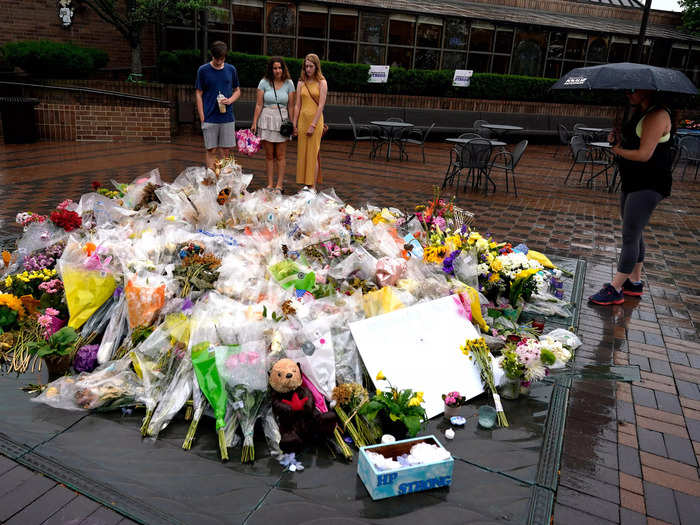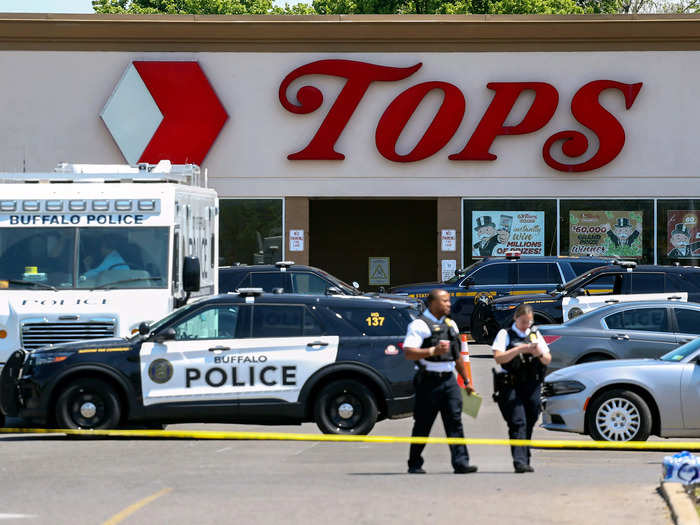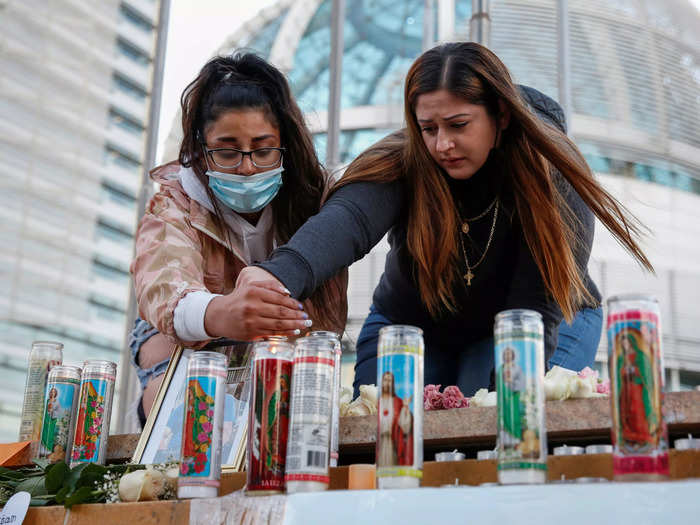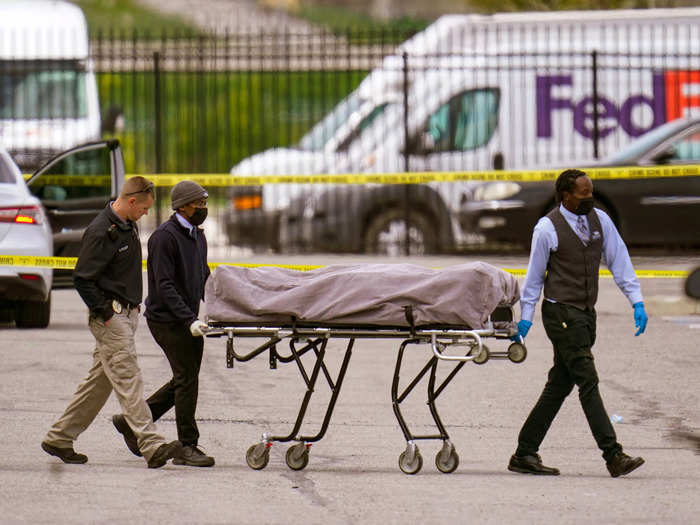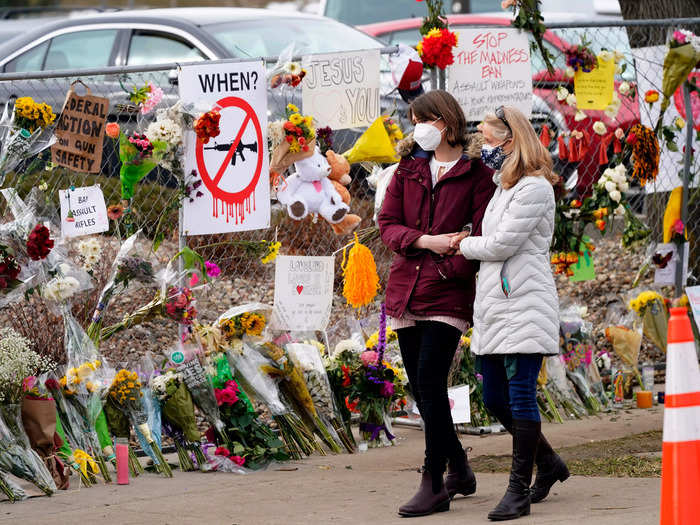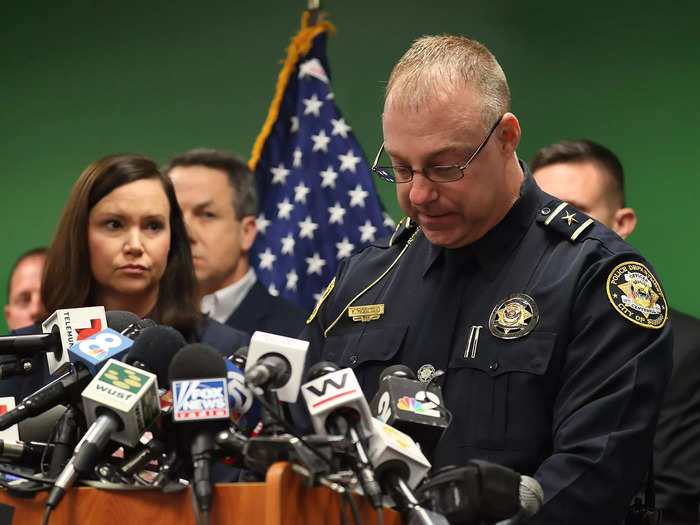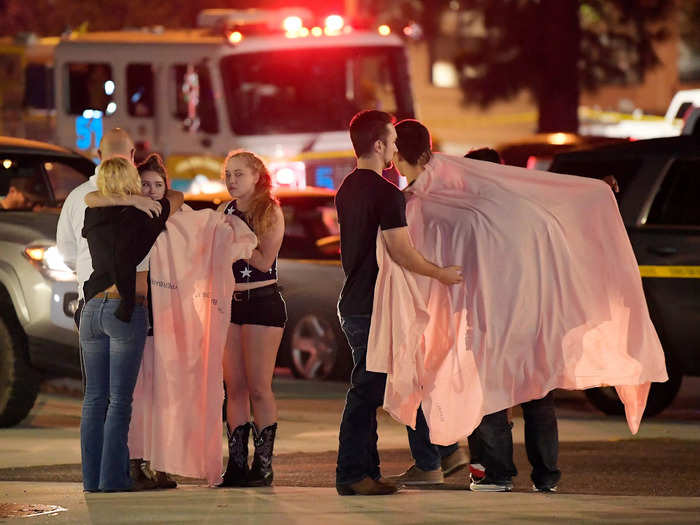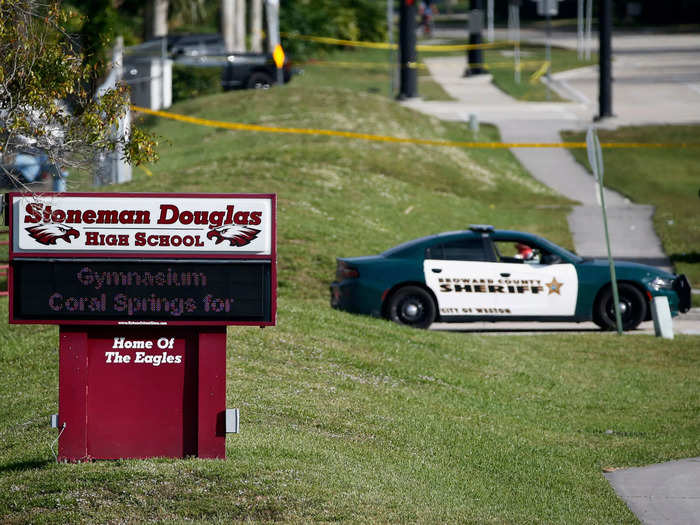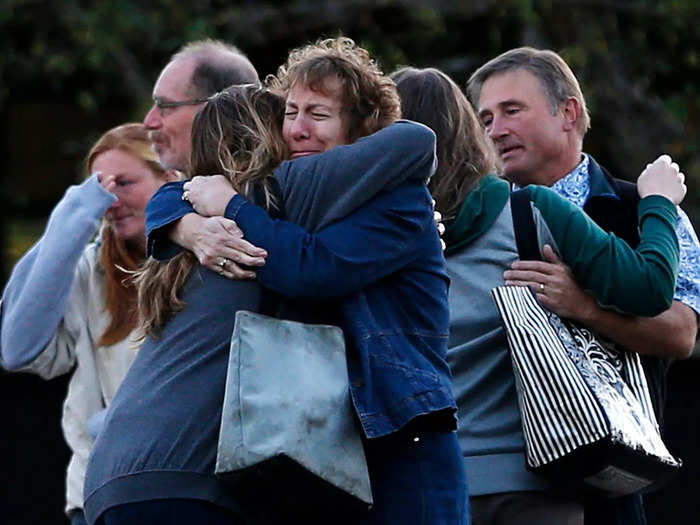A memorial for the victims of a mass shooting at a Fourth of July parade is seen on July 6, 2022 in Highland Park, Illinois.Jim Vondruska/Getty Images
- In at least nine mass shootings, suspects purchased guns despite being in red flag law states.
- Studies have shown that the measure can be an effective way to prevent mass shootings.
As the US continues to be rocked by a chain of deadly mass shootings, lawmakers and the public have made loud calls to rein in firearm ownership through stronger federal gun laws.
This summer, President Joe Biden signed into law the Bipartisan Safer Communities Act — the most significant piece of gun legislation to pass in decades. Part of the bill includes $750 million in federal funding for states to implement intervention programs such as gun restraining orders, more colloquially known as "red flag laws."
The scope of the law varies by state, but it generally allows law enforcement, family members, and sometimes school staff to petition someone's firearms to be confiscated if they present a danger to themselves or to others.
But the Fourth of July shooting in Highland Park, Illinois, which killed seven people and injured dozens more put that measure under the spotlight once again.
The shooting suspect exhibited the types of issues that could have triggered Illinois' red flag law that was enacted in 2019, according to The Chicago Tribune. Yet, around 2020 and 2021, he was able to purchase the rifle used during the attack in a state with some of the strongest gun laws in the country, based on rankings from the Giffords Law Center to Prevent Gun Violence.
Insider also found at least eight other cases of shootings with three or more fatalities, in which the suspect or perpetrator was known to have shown concerning behaviors, such as threats to themselves or the public, by mental health evaluators, law enforcement, or family members, and purchased a firearm in a state with a gun restraining order.
Does this mean red flag laws don't work?
"Red flag laws are an intuitive law and they're a popular law," Veronica Pear, a researcher in the Violence Prevention Research Program at the University of California, Davis, who studied red flag laws in California, told Insider. "And, anecdotally, we can say that they've disarmed many people who were making threats of mass shootings."
When the law is used, Pear and her researchers found that the measure can be effective. Looking at California, researchers found that out of the 201 cases the state's gun restraining orders were utilized, almost 30% of them, or 58 cases, involved individuals making mass shooting threats.
Currently, 19 states and the District of Columbia have some form of a red flag law in place. About 16 of those jurisdictions enacted the law on or after 2018, following the Marjory Stoneman Douglas High School shooting in Parkland, Florida.
When California implemented its Gun Violence Restraining Orders in 2016, Pear's study found that law enforcement didn't take full advantage of the measure until at least two years after it went into effect.
"That would explain of course why we had so few orders issued in the first couple of years," she said.
Other issues Pear's research team found around implementation included a lack of funding for training and, in some cases, law enforcement's unwillingness to use the law, especially in areas where there is a strong culture of gun ownership.
"There can be cultural barriers within police departments," Pear said. "In Colorado, we saw sheriffs coming out and saying that they would refuse to petition for these orders."
Here are several cases where shooters slipped through the cracks of their state's red flag laws.
Highland Park Fourth of July parade shooting in Highland Park, Illinois. July 4, 2022.
Local residents pay their respects at a memorial to the seven people killed and others injured in the Fourth of July mass shooting in Highland Park, Illinois. Nam Y. Huh/AP
Before he was charged for the deadly Highland Park Fourth of July parade shooting in Illinois, Robert Crimo III attempted suicide on April 2019, resulting in a visit from local police officers. Family members assured authorities that he would receive help for his mental health, according to The Chicago Tribune.
Five months after his suicide attempt, the shooting suspect made threats to kill people, The Tribune reported. Officers confiscated 16 knives, a dagger, and a sword from his residence. There were no guns. The suspect did not yet have a permit to purchase one.
A few months later, he secured a permit through a sponsorship signed off by his father.
Law enforcement said after the shooting that they could not have used the state's red flag law, which allows authorities to petition to strip away someone's guns. There was no permit to revoke since the suspect did not have one.
Additionally, no complaints were filed against him by family members and law enforcement to prevent the suspect from getting his application approved.
The suspect purchased five weapons between 2020 and 2021, including one that was used in the attack that killed seven people and injured dozens more.
Tops Friendly Market shooting in Buffalo, New York. May 14, 2022.
Police walk outside the Tops grocery store on May 15, 2022, in Buffalo, New York. Joshua Bessex/AP
Payton Gendron is suspected of killing 10 people in a racist assault against Black people at a Buffalo, New York, grocery store.
In 2021, the shooting suspect was said to have received a mental health evaluation after making threats at his high school — comments he initially explained as a joke, according to The New York Times. Online postings revealed that the suspect lied to evaluators: "That is the reason I believe I am still able to purchase guns. It was not a joke," he wrote, according to The Times.
Law enforcement did not use the state's red flag law for the 18-year-old shooting suspect. In New York, relatives, school officials, and law enforcement are able to petition for a gun restraining order.
The shooting suspect passed an instant background check and purchased a semiautomatic rifle used in the attack.
Shortly after the shooting, Gov. Kathy Hochul expanded the state's red flag law to require state police to use the measure whenever there is "probable cause" that an individual may be a threat to themselves or others and to allow for mental health practitioners to use the law.
Santa Clara Valley Transportation Authority shooting in San Jose, California. May 26, 2021.
Alyssa Rubino and Christina Gonzalez light a candle for their cousin Michael Joseph Rudometkin during a vigil for victims of a shooting at a rail yard run by the Santa Clara Valley Transportation Authority in San Jose, California, on May 27, 2021. Brittany Hosea-Small/Reuters
Samuel James Cassidy, 57, killed nine of his co-workers at a Santa Clara Valley Transportation Authority rail yard and himself on May 26, 2021.
US Customs and Border Protection once noted in 2016 that the shooter had "dark thoughts about harming" two people, but local law enforcement was never further alerted.
The district attorney of Santa Clara County told The Mercury News that authorities could have sought to confiscate weapons using California's Gun Violence Restraining Order had they been warned about the encounter.
The state's red flag law is more extensive than most states in that it allows not just law enforcement but family members, household members, employers, co-workers, and teachers to petition a judge to take away someone's guns.
At his home, Cassidy had stockpiled a dozen guns and 25,000 rounds of ammunition.
FedEx shooting in Indianapolis, Indiana. April 15, 2021.
A body is taken from the scene where multiple people were shot at a FedEx Ground facility in Indianapolis, Indiana. Michael Conroy/AP
Less than a year before eight people were killed at a FedEx facility, the mother of Brandon Hole, the gunman, went to the Indianapolis Metropolitan Police Department on March 2020, seeking help after her son purchased a weapon, struck her in the arm, and told her that he was going to shoot police officers. He also mentioned suicidal thoughts, according to an ABC news report.
At his home, police found that the shooter was browsing white supremacist websites and seized a brand new shotgun from the property. The 18-year-old at the time was placed in a mental health detention center and later transported to a local hospital.
A red flag law hearing was not held for the shooter because law enforcement said there was not enough time to build a successful case that the shooter's guns needed to be confiscated, according to The Associated Press.
Indiana's red flag law, which was enacted in 2005, was amended in 2019 to require courts to hold a hearing in 14 days and that an affidavit be filed with the court in 48 hours.
Four months after the incident, the shooter legally purchased an assault rifle and another one two months later. The shooter killed eight people before killing himself.
King Soopers grocery store shooting in Boulder, Colorado. March 21, 2021.
Mourners walk along the temporary fence put up around the parking lot of a King Soopers grocery store where a mass shooting took place. David Zalubowski/AP
Ahmad Al Aliwi Alissa was known to have a temper and became increasingly "paranoid" a few years before authorities alleged he killed 10 people at a Boulder, Colorado grocery store, according to a CNN report.
In 2018, he was placed on a one-year probation for attacking a high school classmate. Because the incident was a misdemeanor and not a felony, it did not prevent the shooting suspect from purchasing a weapon legally under Colorado law, which includes a universal background check and a red flag law.
A city ordinance banning assault-style rifles and high-capacity magazines was struck down by a judge just days before the shooting, according to U.S. News.
SunTrust Bank shooting in Sebring, Florida. January 23, 2019.
Karl Hoglund, Chief of Police Sebring Police Department, speaks during a press conference about the shooting at a SunTrust Bank branch in Sebring, Florida. Joe Raedle/Getty Images
Zephen Xaver was 21 at the time he was charged with five counts of first-degree murder after the shooting at a Sun Trust Bank branch in Sebring, Florida.
When he was a student at Bremen High School, the shooting suspect was sent to a mental health center after he told his school counselor that he had dreams of killing students, according to CNN. In March 2017, the Bremen Police Department was contacted after a female student received messages from the shooting suspect, stating that he was "possibly thinking of suicide by cop" and "taking hostages."
The shooting suspect purchased a gun six days before the incident.
It's unclear why authorities did not seek what's known in Florida as a "risk protection order" for the shooting suspect. Under state law, law enforcement officials are the only ones who can petition to confiscate someone's guns.
Borderline Bar & Grill shooting in Thousand Oaks, California. November 7, 2018.
People comfort each other as they stand near the scene in Thousand Oaks, California, where a gunman opened fire on November 7, 2018, inside a country dance bar crowded with hundreds of people. Mark J. Terrill/AP
Ian David Long, 28, was a Marine veteran who received a visit from a mental health specialist and local sheriff's deputies just months before he carried out a deadly attack at a bar in Thousand Oaks, California.
The specialist found that he may be suffering from post-traumatic stress disorder, but ultimately did not determine that the shooter needed to be involuntarily admitted under state law, according to CNN.
The perpetrator killed 13 people, including himself with a self-influencted gunshot wound, and injured dozens more on November 7, 2018, using a legally purchased .45-caliber pistol and extended magazine.
Law enforcement did not utilize the state's red flag law at the time. The law was later expanded to allow employers, co-workers and teachers to petition a judge to confiscate firearms.
Marjory Stoneman Douglas High School shooting in Parkland, Florida. February 14, 2018.
Law enforcement officers block off the entrance to Marjory Stoneman Douglas High School in Parkland, Florida. Wilfredo Lee/AP
Nikolas Cruz, who faces the death penalty for his attack at Marjory Stoneman Douglas High School in 2018, was involved in 18 incidents in which the sheriff's office had to respond to calls at the suspect's residence.
Family members, classmates, and neighbors all expressed concerns about the shooter.
He was expelled from Marjory Stoneman Douglas High School and, after he started to cut himself and post images of self-harm on social media, was approached by the Florida Department of Children and Families. The department concluded that he has depression but presented no risk of harm to himself and others, according to NPR.
The FBI was also warned of the shooter in two separate tips notifying the agency that he had intentions to carry out a school shooting. The FBI would later say that "protocols were not followed," NPR reported.
The perpetrator legally purchased a rifle from a licensed dealer on February 2017. Florida's red flag law allows only law enforcement to petition for guns to be confiscated.
Umpqua Community College shooting in Roseburg, Oregon. October 1, 2015.
Faculty members embrace on their return to Umpqua Community College in Roseburg, Oregon, on October 5, 2015, after a mass shooting killed nine people. John Locher/AP
Christopher Harper-Mercer, a 26-year-old who killed nine people and himself at Umpqua Community College near Roseburg, Oregon, was reportedly discharged from the Army in 2008 after an attempted suicide, according to The Wall Street Journal — behavior that is grounds for family members or law enforcement to ask a court to confiscate weapons under Oregon's red flag law.
The shooter had also left material behind that detailed his rage and his desire to seek revenge against people and to emulate mass shooters before him, according to a report from The Los Angeles Times.
In the interview with The LA Times, his mother, Laurel Harper, said that she never called the police during his meltdowns because she was afraid that he would go to jail. She also told detectives that she didn't see clear signs that may have led to the deadly attack.
Six legally purchased weapons were recovered from the site of the shooting.

